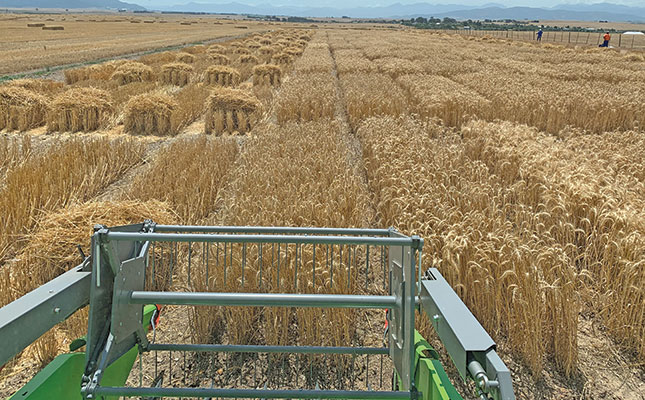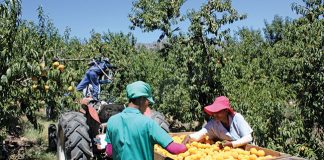
Photo: Supplied
Knowledge is crucial to success in crop production, and seldom more so than for wheat in South Africa, where growing conditions vary and much of the country’s supply is imported.
Producers need to base short- and long-term planning on the latest market and industry information so they can adapt when required to increase profit per hectare.
To succeed, a farmer has to understand his or her specific production area, take note of long-term climate conditions, and keep up with the latest cultivars.
Choosing cultivars
Cultivar choice is a key production decision and can contribute to reducing risk and optimising yield. The selection of a cultivar is principally an economic decision, where the producer must find a balance between risk and yield potential.
The yield potential of the wheat, in combination with the production area, climate and soil type, is as important as the management of input and production costs.
Cultivars differ in characteristics such as area adaptability, yield potential and stability, agronomic characteristics, as well as tolerance of diseases, pests and aluminium toxicity.
New varieties are released frequently, and it is important to understand their characteristics and how they fit into the farm’s cropping system.
Follow these useful guidelines when considering a wheat cultivar:
- Identify the specific production area. This will determine the adaptability and disease profile required of the cultivar.
- Determine the subregion of production.
Two factors control the growth period: photoperiod (day length; in other words, the period during which the plant receives sunlight) and vernalisation (the cooling of the seed in winter to enable it to produce flowers). The cultivar must therefore be adapted to climatic conditions such as the length of the growing season, rainfall pattern, temperature, soil water availability at planting, and the first and last frost dates.
Take agronomic characteristics, such as lodging, shattering, disease susceptibility or tolerance, and grain quality into account when making your decision.
Base your cultivar selection on reliable long-term data and take note of new, improved cultivars every year, as well as the recommended optimal planting spectrum for each cultivar. Put together a cultivar package that will minimise production risks such as drought, disease occurrence and crop rotation time constraints in your area.
Quality seed
When planting, strive to achieve as high a yield as possible from the seed sown. One of the most effective ways of achieving this is by planting high-quality seed.
Certified seed is the starting point of a successful crop, as well as an important risk management tool. Certified wheat seed offers many advantages over farm-saved seed:
- Varietal purity;
- Traceability, protection and peace of mind;
- A system for the follow-up of complaints;
- Professionally treated seed;
- Clean seed. Certified seed is grown and processed under stringent production requirements with strict limits on weeds and other types of crop;
- New genetics.
Seeding density
Crop or seeding density is a key agronomical aspect used to manage wheat crops and estimate yield. To calculate total grain yield per hectare, you will need to estimate the average number of plants per hectare, ears per plant, grains per ear, and grain weight of each kernel.
Seeding density is an important production factor; when managed optimally, it can save you money and maximise your profitability.
“It remains critical, however, that the producer must look at the recommendations set by the seed company regarding seeding or planting density for that specific cultivar,” says Dr André du Toit, Africa wheat lead at Corteva.
You will need to strike a fine balance between costs per hectare and the establishment of seedlings for optimal grain yield. Good yields and profitability can only be achieved through careful planning and management. Higher yields usually imply higher profits, since production costs per ton of grain decline relatively as yields increase.
There are, however, a number of critical aspects to consider. Plant population density may significantly affect the competition among plants as well as with weeds, and consequently affect the utilisation of resources such as light, water and nutrients.
Planting density and row spacing will depend on various factors. To begin with, make sure you plant the seed evenly, at a shallow depth and in moist soil. The seeding density can vary from 15kg/ha to 35kg/ha under dryland conditions, and 65kg/ha to 200kg/ha under irrigation, depending on the area, the specific cultivar, and the moisture availability of the soil.
The recommended seeding densities include a safety factor to ensure an optimal plant population under most conditions. Seeding density can also compensate for lower seed viability, poorer emergence due to the planting conditions, and suboptimal plant establishment.
Calculating the seeding rate
The use of seeding densities is linked to the recommendations for plant populations
required per cultivar (plants/m2) and is adjusted according to the thousand kernel mass (TKM) values per seed lot of a cultivar.
The TKM is an important value, as it indicates the number of kernels/ kg of seed. This value can vary significantly, and influences the calculation of the seeding density (kg/ ha) for the target plant population/m2.
The TKM and tested germination percentage of the seed batch are listed on the seed label of each bag of seed. The smaller and lighter the seeds, (that is, the lower the TKM values), the less seed is required to reach the recommended plants/m2.
Seeding density (kg/ha) = plants/m2 x TKM (in grams) divided by the establishment percentage. An establishment percentage of 100% can be used, but 80% is generally used.
At 100% establishment, the formula will be: seeding density (kg/ha) = plants/m2 x TKM/100. So, for example, if plants/m2 = 275 and TKM = 38g, then 275 x 38 = 10 450, divided by 100 to give a seeding density of 104,5kg/ha.
The effect of smaller seeds on germination, emergence and seedling vigour should also be considered. Although kg/ha can be reduced to reach similar seeds/ha in comparison with larger seeds (higher TKM), the final number of established plants may be lower because of poorer seedling growth if planting conditions are not optimal.
According to Pieter Craven, sales and marketing manager at Sensako, farmers should keep in mind that the TKM and germination capacity of seed can vary from year to year, and seeding density should be adjusted accordingly.
“Planting density will vary depending on the season, cultivar planted, status of the seedbed, the planting date, irrigation method and the planter used. It’s important to note that seedbed preparation plays a vital role where lower planting densities are used,” says Craven.
Seeding rates for broadcast spreading and subsequent cultivation to cover the seed with soil have to be up to 30% higher due to seed losses caused by birds, as well as uneven germination and emergence due to varying seed placement depth after cultivation.
The later that wheat is planted in the planting spectrum for a specific cultivar, the higher the seeding density generally needs to be to ensure that the crop achieves optimal yield potential in ears/m2.
If planting conditions are suboptimal and could therefore potentially affect germination and possibly emergence, you should increase seeding density to compensate. Lower density increases the risk of suboptimal plant populations if external factors limit germination, emergence and establishment of the crop.
Dryland vs irrigated plantings
In dryland production systems, the choice of planting date will influence seeding rate. True winter-type cultivars are planted earlier in the season to enable vernalisation capacity to be realised through sufficient cold units accumulated during the early-winter period. Generally, this enables the plant to initiate more tillers during the early growth period.
As the planting season progresses, fewer cold units are available for vernalisation, and there is a risk of reduced tillering. To ensure sufficient ears/m2, you will need to plant a higher seeding density.
These agronomic details are measured through different planting date trials during cultivar development and are linked to grain yield. During the planting spectrum in different climatic regions, an optimal seeding density range is calculated for each cultivar.
For irrigated production, the genetic make-up of these wheat cultivars is usually quite different from the dryland material. Under irrigation, the grain yield potential is significantly higher.
Generally, spring types are planted. Spring wheat has a reduced plant height (shorter straw length) to counter probable lodging of plants at higher yields, but this also reduces the length of the coleoptile (the sheath that protects the young shoot tip) in the seedlings.
However, these cultivars have reduced tillering capacity, shorter growing seasons and reduced vernalisation requirements. Together, these factors mean that you should use a higher recommended seeding density to ensure optimal ears/m2, and establish an optimal sink-source relationship to support the higher potential yield.
Growth period
The optimal planting density varies according to the length of the cultivar’s growth period, with shorter growers requiring higher densities to compensate for reduced tillering and the shortened growing season. Densities can range from 275 plants/m2 to 350 plants/m2, or 100kg/ha to 130kg/ha (TKM of 32g, and 90% establishment).
“The latest developments in our breeding programme, combined with seed treatment, are, however, opening up the possibility of lower planting densities.
The recommended seeding rate of Pannar’s irrigation cultivars is between 65kg/ha to 100kg/ha (depending on early and late planting dates). But, once again, it remains necessary to follow the specific recommendations given for each cultivar by individual companies,” Du Toit stresses.
Producers who grow wheat in the winter rainfall regions of the Western Cape use cultivars with a different genetic make-up that thrive in those conditions. They have low vernalisation requirements and high tillering capacity, and are suited to narrower row widths.
Because of soil type and planting conditions, recommended seeding densities are 150 plants/ m2 to 200 plants/ m2 under dryland conditions, and 200 plants/m2 to 250 plants/m2 under supplementary irrigation. This can be adjusted according to planting conditions, soil type, area, yield potential and cultivar characteristics.
Optimal seeding density is researched constantly via seeding density trials in all areas. Higher densities are more suitable in higher rainfall years, although the weather conditions of the season will obviously not be known with certainty at planting.
Where no-till cultivation is practised in parts of the Western Cape, a minimum target planting density of 175 plants/m2 to 200 plants/m2 should be aimed for.
Email André du Toit at [email protected].











